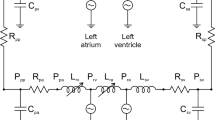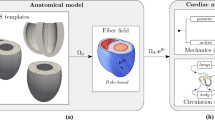Abstract
Mechanical interplay between the adjacent ventricles is one of the principal modulators of physiopathological heart function, and the underlying mechanisms of interaction are only partially understood, hence hampering clinically useful interpretation of imaging data. In order to characterize the influence of chamber geometry on ventricular coupling, the ventricles and septum are modeled as portions of ellipsoidal shells, and configuration is derived as a function of pressure gradients by combining shell element equilibrium equations through static boundary conditions applied at the sulcus. Diastolic volume (v) surfaces are calculated as a function of pressure (p), contralateral pressure (clp) and intrathoracic pressure (p t ) and match literature data where available. Ventricular interaction is characterized in terms of partial derivatives in v–p–clp–p t space both under physiological and altered (selectively stiffened walls) conditions. The model allows prediction of diastolic ventricular v–p–clp–p t interplay in a variety of physiopathological circumstances.






Similar content being viewed by others
References
Kingma I, Tyberg JV, Smith ER (1983) Effects of diastolic transseptal pressure gradient on ventricular septal position and motion. Circulation 6:1304–1314
Beyar R, Dong SJ, Smith ER et al (1993) Ventricular interaction and septal deformation: a model compared with experimental data. Am J Physiol 6(Pt 2):H2044–H2056
Brinker JA, Weiss JL, Lappe DL et al (1980) Leftward septal displacement during right ventricular loading in man. Circulation 3:626–633
Francone M, Dymarkowski S, Kalantzi M et al (2006) Assessment of ventricular coupling with real-time cine MRI and its value to differentiate constrictive pericarditis from restrictive cardiomyopathy. Eur Radiol 4:944–951
Santamore WP, Burkhoff D (1991) Hemodynamic consequences of ventricular interaction as assessed by model analysis. Am J Physiol 1(Pt 2):H146–H157
Slinker BK, Glantz SA (1986) End-systolic and end-diastolic ventricular interaction. Am J Physiol 5(Pt 2):H1062–H1075
Little WC, Badke FR, O’Rourke RA (1984) Effect of right ventricular pressure on the end-diastolic left ventricular pressure–volume relationship before and after chronic right ventricular pressure overload in dogs without pericardia. Circ Res 6:719–730
Santamore WP, Constantinescu M, Shaffer T (1988) Predictive changes in ventricular interdependence. Ann Biomed Eng 2:215–234
Chung DC, Niranjan SC, Clark JW Jr et al (1997) A dynamic model of ventricular interaction and pericardial influence. Am J Physiol 6(Pt 2):H2942–H2962
McDonald IG, Feigenbaum H, Chang S (1972) Analysis of left ventricular wall motion by reflected ultrasound. Application to assessment of myocardial function. Circulation 1:14–25
Yamaguchi S, Tsuiki K, Miyawaki H et al (1989) Effect of left ventricular volume on right ventricular end-systolic pressure–volume relation. Resetting of regional preload in right ventricular free wall. Circ Res 3:623–631
Li KS, Santamore WP (1993) Contribution of each wall to biventricular function. Cardiovasc Res 5:792–800
Janicki JS, Weber KT (1980) The pericardium and ventricular interaction, distensibility, and function. Am J Physiol 4:H494–H503
Duke GJ (1999) Cardiovascular effects of mechanical ventilation. Crit Care Resusc 4:388–399
Mitchell JR, Whitelaw WA, Sas R et al (2005) RV filling modulates LV function by direct ventricular interaction during mechanical ventilation. Am J Physiol Heart Circ Physiol 2:H549–H557
Francone M, Dymarkowski S, Kalantzi M et al (2005) Real-time cine MRI of ventricular septal motion: a novel approach to assess ventricular coupling. J Magn Reson Imaging 3:305–309
Farrar DJ, Chow E, Brown CD (1995) Isolated systolic and diastolic ventricular interactions in pacing-induced dilated cardiomyopathy and effects of volume loading and pericardium. Circulation 5:1284–1290
Yamaguchi S, Li KS, Harasawa H et al (1993) Acute alterations in systolic ventricular interdependence-mechanical dependence of right ventricle on left ventricle following acute alteration of right ventricular free wall. Basic Res Cardiol 4:350–361
Seki S, Itano T, Motohiro K et al (1977) Mechanodynamics at the interventricular sulcus–reciprocal effect of the ventricles on the ventricular function. Jpn Circ J 9:967–974
Wong AY, Rautaharju PM (1968) Stress distribution within the left ventricular wall approximated as a thick ellipsoidal shell. Am Heart J 5:649–662
Nash MP, Hunter PJ (2000) Computational Mechanics of the Heart. J Elast 61:113–141
Stevens C, Remme E, Legrice I et al (2003) Ventricular Mechanics in diastole: material parameter sensitivity. J Biomech 36:737–748
Mirsky I (1973) Ventricular and arterial wall stresses based on large deformation analyses. Biophys J 11:1141–1159
Janz RF (1982) Estimation of local myocardial stress. Am J Physiol 5:H875–H881
Taber LA (1991) On a nonlinear theory for muscle shells: part II—application to the beating left ventricle. J Biomech Eng 1:63–71
Azhari H, Buchalter M, Sideman S et al (1992) A conical model to describe the nonuniformity of the left ventricular twisting motion. Ann Biomed Eng 2:149–165
Santamore WP, Bartlett R, Van Buren SJ et al (1986) Ventricular coupling in constrictive pericarditis. Circulation 3:597–602
Woodard JC, Chow E, Farrar DJ (1992) Isolated ventricular systolic interaction during transient reductions in left ventricular pressure. Circ Res 5:944–951
Santamore WP, Shaffer T, Hughes D (1986) A theoretical and experimental model of ventricular interdependence. Basic Res Cardiol 5:529–538
Ventsel E, Krauthammer T (2001) Thin plates and shells: theory, analysis, and applications. CRC, New York
Omens JH, May KD, McCulloch AD (1991) Transmural distribution of three-dimensional strain in the isolated arrested canine left ventricle. Am J Physiol 3(Pt 2):H918–H928
Janicki JS, Weber KT (1980) Factors influencing the diastolic pressure–volume relation of the cardiac ventricles. Fed Proc 2:133–140
Weber KT, Janicki JS, Shroff S et al (1981) Contractile mechanics and interaction of the right and left ventricles. Am J Cardiol 3:686–695
McCulloch AD, Omens JH (1991) Non-homogeneous analysis of three-dimensional transmural finite deformation in canine ventricular myocardium. J Biomech 7:539–548
McCulloch AD (1995) Cardiac biomechanics. CRC Press, Boca Raton
Santamore WP, Shaffer T, Papa L (1990) Theoretical model of ventricular interdependence: pericardial effects. Am J Physiol 1(Pt 2):H181–H189
Omens JH, MacKenna DA, McCulloch AD (1993) Measurement of strain and analysis of stress in resting rat left ventricular myocardium. J Biomech 6:665–676
Smith BW, Chase JG, Nokes RI et al (2004) Minimal haemodynamic system model including ventricular interaction and valve dynamics. Med Eng Phys 2:131–139
Glantz SA, Misbach GA, Moores WY et al (1978) The pericardium substantially affects the left ventricular diastolic pressure-volume relationship in the dog. Circ Res 3:433–441
Taher MF, Santamore WP, Bogen DK (1994) Ventricular interaction is described by three coupling coefficients. Am J Physiol 1(Pt 2):H228–H234
Scharf SM, Woods BO, Brown R et al (1987) Effects of the Mueller maneuver on global and regional left ventricular function in angina pectoris with or without previous myocardial infarction. Am J Cardiol 15:1305–1309
Santamore WP, Heckman JL, Bove AA (1983) Cardiovascular changes from expiration to inspiration during IPPV. Am J Physiol 2:H307–H312
Feit TS (1979) Diastolic pressure-volume relations and distribution of pressure and fiber extension across the wall of a model left ventricle. Biophys J 1:143–166
Santamore WP, Dell’Italia LJ (1998) Ventricular interdependence: significant left ventricular contributions to right ventricular systolic function. Prog Cardiovasc Dis 4:289–308
Maruyama Y, Ashikawa K, Isoyama S et al (1982) Mechanical interactions between four heart chambers with and without the pericardium in canine hearts. Circ Res 1:86–100
Kroeker CA, Shrive NG, Belenkie I et al (2003) Pericardium modulates left and right ventricular stroke volumes to compensate for sudden changes in atrial volume. Am J Physiol Heart Circ Physiol 6:H2247–H2254
Moulton MJ, Creswell LL, Downing SW et al (1994) Ventricular interaction in the pathologic heart. A model based study. ASAIO J 3:M773–M783
Schmid H, Nash MP, Young AA et al (2006) Myocardial material parameter estimation—a comparative study for simple shear. J Biomech Eng 5:742–750
Author information
Authors and Affiliations
Corresponding author
Rights and permissions
About this article
Cite this article
Toschi, N., Guerrisi, M. Interventricular coupling coefficients in a thick shell model of passive cardiac chamber deformation. Med Biol Eng Comput 46, 637–648 (2008). https://doi.org/10.1007/s11517-008-0324-0
Received:
Accepted:
Published:
Issue Date:
DOI: https://doi.org/10.1007/s11517-008-0324-0




